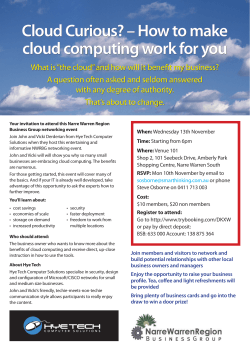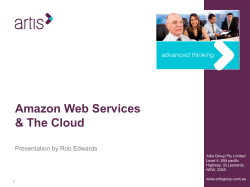
TechGuide 3 - Auburn University
3 Cloud Computing 1. Describe the problems that modern information technology departments face. 2. Describe the key characteristics and advantages of cloud computing. 3. Identify a use-case-scenario for each of the four types of clouds. 4. Explain the operational model of each of the three types of cloud services. 5. Identify the key benefits of cloud computing. 6. Discuss the concerns and risks associated with cloud computing. 7. Explain the role of Web services in building a firm’s IT applications, providing examples. 1. Introduction 2. What Is Cloud Computing? 3. Different Types of Clouds 4. Cloud Computing Services 5. The Benefits of Cloud Computing 6. Concerns and Risks with Cloud Computing 7. Web Services and Service-Oriented Architecture TG Introduction 3.1 • IT Infrastructure • Evolution of the Modern IT Infrastructure IT Infrastructure • IT Components – Hardware – Software – Networks – Databases – IT Services • (Developing Information Systems, Managing Security and Risk, and Managing Data) Evolution of the Modern IT Infrastructure 1. 2. 3. 4. Stand-alone Mainframes Mainframe and Dumb Terminals Stand-alone Personal Computers Local Area Networks (Client/Server Computing) 5. Enterprise Computing 6. Cloud Computing and Mobile Computing TG What is Cloud Computing? 3.2 • Cloud Computing Characteristics Cloud Computing Characteristics – Cloud Computing Provides On-Demand SelfService – Cloud Computing Encompasses the Characteristics of Grid Computing • Grid Computing enables organizations to utilize resources more efficiently • Grid Computing provides fault tolerance and redundancy • Grid Computing makes it easy to scale up • Grad Computing makes it easy to scale down Cloud Computing Characteristics (Continued) – Cloud Computing Encompasses the Characteristics of Utility Computing – Cloud Computing Utilizes Broad Network Access – Cloud Computing Pools Computing Resources – Cloud Computing Often Occurs on Virtualized Servers • Server Farms • Server Virtualization TG Different Types of Clouds 3.3 • Public Cloud • Private Cloud (or Corporate Cloud) • Hybrid Cloud • Vertical Clouds TG Cloud Computing Services 3.4 • Infrastructure-as-a-Service (IaaS) • Platform-as-a-Service (PaaS) • Software-as-a-Service (SaaS) Platform-as-a-Service (PaaS) • PaaS offers several advantages to customers: – Application developers can develop and run their software solutions on a cloud platform without the cost of buying and managing the underlying hardware and software layers – Underlying computing and storage resources automatically scale to match application demand – Operating system features can be upgraded frequently Platform-as-a-Service (PaaS) (Con’t) • PaaS offers several advantages to customers (Con’t): – Geographically distributed development teams can work together on software development projects – PaaS services can be provided by diverse sources located throughout the world – Initial and ongoing costs can be reduced by the use of infrastructure services from a single vendor TG The Benefits of Cloud Computing 3.5 • Seven Major Benefits to Individuals and Organizations Seven Major Benefits of Cloud Computing to Individuals & Organizations • Benefit 1: Making Individuals More Productive • Benefit 2: Facilitating Collaboration • Benefit 3: Mining Insights from Data • Benefit 4: Reduce Costs Seven Major Benefits of Cloud Computing to Individuals & Organizations (Con’t) • Benefit 5: Expand the Scope of Business Operations • Benefit 6: Respond Quickly to Market Changes • Benefit 7: Customize Products and Services TG Concerns and Risks with Cloud Computing 3.6 • Five Categories of Concerns Five Categories of Cloud Computing Concerns • Concern 1: Legacy IT Systems • Concern 2: Reliability – Example: Amazon Web Services • Concern 3: Privacy • Concern 4: Security • Concern 5: The Regulatory and Legal Environment TG Web Services and ServiceOriented Architecture 3.7 • Benefits Provided to Organizations by Web Services • Service-Oriented Architecture • Web Services are based on Four Key Protocols Benefits Provided to Organizations by Web Services • The organization can utilize the existing Internet infrastructure without having to implement any new technologies • Organizational personnel can access remote or local data without having to understand the complexities of the process • The organization can create new applications quickly and easily Web Services are based on four key protocols: • Extensible Markup Language (XML) • Simple Object Access Protocol (SOAP) • Web Services Description Language (WSDL) • Universal Description, Discovery, and Integration (UDDI)
© Copyright 2025









